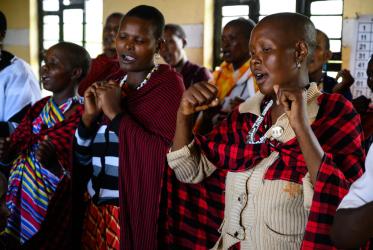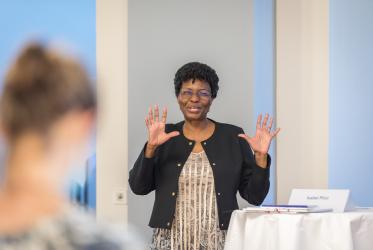Dear Sisters and brothers in our Lord Jesus Christ
It is a pleasure and honour for me to bring to you greetings from the Rev Dr Olav Fykse Tveit, the general secretary of the World Council of Churches (WCC) on this special occasion of the Mennonite World Assembly in 2015. On behalf of the WCC, I would like to congratulate you for holding this assembly which is a clear symbol of visible unity within the Mennonite family - a part of the body of our Lord Jesus Christ. Unity between and within churches is what WCC stands for as a fellowship of 345 churches representing over 500 million Christians in 120 countries ‘to call one another to visible unity…witness and service to the world and to advance towards that unity in order that the world may believe’.[1]
The assembly gives the WCC an opportunity to acknowledge with appreciation the following contribution of the Mennonites to the ecumenical movement:
First, the ecumenical family learns from your commitment to a theology of peace. Since the foundations of your churches, you have remained steadfast to the message of our Lord Jesus to love our enemies and therefore reject violence in the struggle for justice. The peace churches, to which you belong, have helped a much larger body of Christ to accept the New Testament imperatives on non-violence. People from other traditions are often drawn towards a wider vision of peace and active non-violence which is needed now more than ever to combat religious extremism which is currently threatening every region of our world. The prevention of violence in all its forms is one area of wide consensus among Christians and therefore a visible testimony of our unity in the world today.
Second, the WCC acknowledges with gratitude that when the eighth assembly of the WCC introduced the "Decade to Overcome Violence: Churches seeking Reconciliation and Peace", the Mennonite saw this as an opportunity to engage the ecumenical movement. New ecumenical theologies of peace have since emerged, which are reflected in the Ecumenical Call to Just Peace[2] with a reference to the development of an ethic of a lawful use of force under a rigorous and conditional application of the just war criteria. A multi-sectorial approach to peace-building is an example of one of the new theologies with the following dimensions:
- Just peace in the community – so that all may live free from fear
- Just peace with the earth – so that life is sustained
- Just peace in the marketplace – so that all may live with dignity
- Just peace among the nations – so that human lives are protected
Third, the WCC acknowledges with gratitude the participation of the Mennonites in the WCC central committee in bringing clarity to the invitation to a pilgrimage of justice and peace as reflected in the Message of the 10th assembly of the WCC held in Busan, South Korea. This Message reminds us that while the 1st WCC assembly in Amsterdam in 1948 was “We intend to stay together”, for the 10th Assembly in 2013 the focus is on “We intend to move together.” [3]
The pilgrimage of justice and peace is a journey of faith and discovery, an ecumenical initiative of the World Council of Churches. The worldwide fellowship of Christian churches invites all Christians to deepen their relationship with God and each other by joining together in prayer, witness and service for justice and peace.
We encounter the God of life in the needs of others. The Pilgrimage asks us to meet the world’s deep and evident need. Intractable conflict, widespread injustice, and environmental peril all invite and demand that Christians journey together, working and walking in solidarity and compassion toward God’s realm of justice and peace.
Let’s open ourselves up to encounter God, engage human need, and be transformed in our lives, our churches, and our world--Join the Pilgrimage!"
Furthermore, participants to an ecumenical peace-building consultation which was held in December 2014 in Sigtuna, Sweden, proposed a method of moving together. It is called the Ecumenical Peace Advocacy Network. You are most welcome to join.
In the search for peace beyond borders – where the WCC is well-placed to convene and to lead – there are ample opportunities for churches of different persuasions to build peace together, to intervene where lives are endangered, to restore where human dignity is denied, to protect where the sanctity of life is at risk, to engage both sides where borders divide and to serve as agents of much-needed change for fullness of life.
I want to conclude with the WCC Busan assembly theme ‘God of Life, lead us to Justice and Peace’ because it is a uniting prayer bringing together the diversity of concerns and expectations into a framework for understanding and commitment to move forward together in a pilgrimage of justice and peace for fullness of life. May this be your prayer too.
Dr Isabel Apawo Phiri
WCC associate general secretary for Public Witness and Diakonia
--------------------
[1] Constitution of the World Council of Churches, Article III.
[2] Official Report of the 10th Assembly of the World Council of Churches, 2013
[3] Official Report of the 10th Assembly of the World Council of Churches, 2013.


